Installation and connection of an expansion tank in open and closed versions of heating systems
To provide the coolant with the ability to expand during heating, you need to install an expansion tank in the heating system. This is a very important event. It will protect pipes and radiators from unnecessary loads and significantly increase the service life of the functional elements of an autonomous heating system.
We will talk about how the expansion tank works in open and closed circuits. We will show you how to correctly install it in both versions of the system. In our article you will find a description of the technology for connecting this reserve capacity and useful recommendations.
The content of the article:
Types and functions of expanders for heating
An expansion tank is needed to compensate for the effect that the increase in the coolant volume on heating has on the heating system. An additional tank connected to the circuit becomes a storage place for the excess water formed. When the temperature drops, part of the coolant leaves the tank and returns to the pipes.
The process is repeated with each cycle of heating and cooling. If such a tank were absent in the system, then when the water inside the pipes was heated, it would increase, and then the pressure would decrease.
Such differences adversely affect the state of the system. They lead to leaks at the junction of devices and pipes and can even cause equipment breakdown.
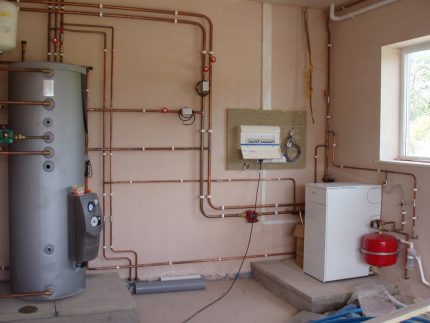
An expansion tank is selected depending on the characteristics of the heating system. For closed circuits, a special closed capsule with a membrane is needed, and for open circuits, an unpressurized container of a convenient configuration and the right size is suitable.
You should choose a membrane tank that is designed for contact with hot water. Typically, the case of such devices is painted red.The tank for installation in an open circuit can be made independently, for example, welded from sheet metal. But it is important not only to choose a suitable device, but also to install it correctly.
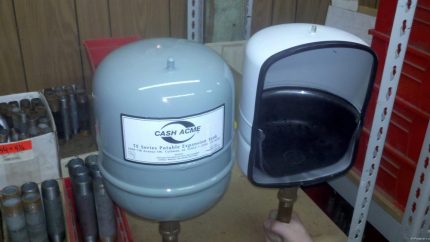
Mounting the membrane device
A hydraulic accumulator of this type is installed where there is a minimal likelihood of coolant swirls, since a pump is used for normal circulation of the water flow along the circuit.
The correct position of the container
When connecting the expansion tank to closed heating system Be sure to consider the location of the air chamber of the device.
The rubber membrane is periodically stretched and then contracted. Due to this effect, microcracks appear on it over time, which gradually increase. After this, the membrane has to be replaced with a new one.
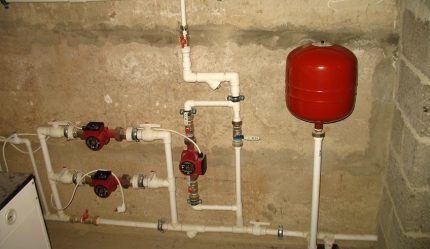
If the air chamber of such a tank during installation remains below, then the pressure on the membrane will increase due to gravitational impact. Cracks will appear faster, repairs will be needed sooner.
It is wiser to install the expansion tank so that the compartment filled with air remains on top. This will extend the life of the device.
Features of the choice of installation location
There are a number of requirements that need to be considered when installing a membrane expansion tank:
- It must not be placed close to the wall.
- Provide easy access to the device for its regular maintenance and necessary repairs.
- The tank suspended on the wall should not be too high.
- A shut-off valve should be installed between the tank and the heating pipes, which will allow you to remove the device without completely draining the coolant from the system.
- The pipes connected to the expansion tank, when wall mounted, also need to be attached to the wall in order to remove the possible additional load from the tank nozzle.
For a membrane device, the return connection between the circulation pump and the boiler is considered the most suitable connection point. Theoretically, you can put expansion tank and on the supply pipe, but the high temperature of the water will adversely affect the integrity of the membrane and its service life.
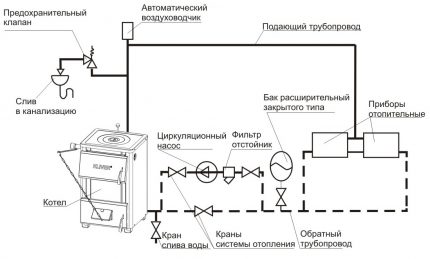
When using solid fuel equipment, such placement is also dangerous because steam can enter the tank due to overheating. This will seriously disrupt the membrane and may even damage it.
In addition to the stopcock and the “American”, it is recommended that when connected, an additional tee and tap be installed, which will allow to empty the expansion tank before shutting down.
Instrument setup before use
Before installation or immediately after it, it is necessary to correctly configure the expansion tank, otherwise called an expanometer. This is not difficult to do, but first you need to find out what pressure should be in the heating system. Suppose an acceptable figure is 1.5 bar.
Now you need to measure the pressure inside the air of the membrane tank. It should be less than about 0.2-0.3 bar. Measurements are carried out with a manometer with a suitable gradation through the nipple connection, which is available on the tank body. If necessary, air is pumped into the compartment or the excess is vented.
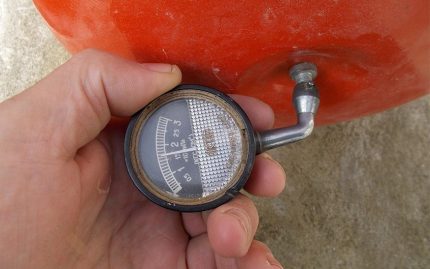
The technical documentation usually indicates the working pressure, which is set by the manufacturer at the factory. But practice shows that this is not always true. During storage and transportation, part of the air could exit the compartment. It is necessary to take your own measurements.
If the pressure in the tank is not set correctly, this can lead to suction of air through the device for its removal. This phenomenon causes a gradual cooling of the coolant in the tank. It is not necessary to pre-fill the membrane tank with coolant, it is enough just to fill the system.
Tank as an additional capacity
Modern models of heating boilers often already equipped with a built-in expansion tank. However, its characteristics do not always correspond to the requirements of a specific heating system. If the built-in tank is too small, an additional tank must be installed.
He will ensure normal coolant pressure in system. Such an addition will be relevant in the event of a change in the configuration of the heating circuit. For example, when a gravity system is redone under a circulation pump and old pipes are left.
This is true for any systems with a significant amount of coolant, for example, in a two-three-story cottage or where, in addition to radiators, there is a warm floor. If you are using a boiler with a built-in membrane tank of a small size, the installation of another tank is almost inevitable.
Expansion tank will be appropriate when using indirect heating boiler. A relief valve, similar to that installed on electric boilers, will not be effective here, an expansomat is an adequate way out.
Connecting the expansion tank
The place for installation of such a tank is chosen where the intake of excess coolant will be most effective.
Finding out how to properly install the expansion tank in open heating system, you need to pay attention to three important points:
- select the highest point of the contour;
- place the tank directly above the heating boiler so that they can be connected by a vertical pipe;
- provide overflow in case of an accident.
The requirements are explained by the features of the functioning of gravity heating systems. The hot heat carrier moves from the boiler through the pipes and reaches the expansion tank, having lost a significant part of the thermal energy.
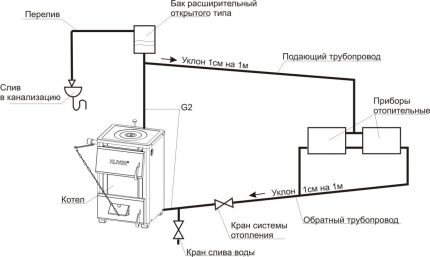
The cooled water naturally flows through the pipes into the heat exchanger for new heating. The location of the tank at the highest point allows you to remove air bubbles entering the system from the coolant.
Calculate capacity tank for open systemgrowth. The total volume of coolant in the circuit is measured, 10% of this indicator will be the desired figure. Most often, an expansion tank is installed in the attic.
This is especially convenient if you need a large capacity, because for the normal operation of the gravity system, you may need a significant amount of coolant. A small expansion tank can even be installed in the kitchen under the ceiling, if this allows you to properly connect it to the boiler.

If the device had to be installed in the attic, you need to take care of its insulation. This is especially important if the attic is not heated. Though coolant and enters the tank already cooled, do not neglect the ability to save part of the thermal energy. In the future, heating will require less time and fuel, which will significantly reduce heating costs.
To connect the expansion tank and overflow, two pipes must be drawn into the boiler room.Overflow is usually connected to the sewer, but sometimes the owners of the house decide simply to bring the pipe out, an emergency discharge is made out.

After the place for expansion tank installation its volume is selected and calculated; it is necessary to find and install a suitable capacity. Small tanks are mounted on the wall using brackets or clamps.
Spacious containers must be installed on the floor. It is not necessary to seal such a tank tightly, but you still need a lid. It is necessary to protect the coolant from debris.
Part of the water from the open system evaporates, the lost volume must be replenished. The coolant is usually added to the open circuit through the expansion tank.
This point must be taken into account when choosing a location for mounting the device. It is not always convenient to carry water with a bucket in the attic. It is simpler to foresee the installation of a feed pipe that leads to an expansion tank.
Conclusions and useful video on the topic
Step-by-step demonstration of the installation and connection of the membrane tank in the heating system:
Interesting tips for installing expansion tank in an open system:
A conventional expansion tank, like a membrane accumulator, is not too difficult to install. No special skills or tools are needed for this. But you need to clearly comply with the requirements associated with the features of the heating system for which such installation is carried out.
Want to talk about how to install the expansion tank with your own hands? Do you have useful information that can help site visitors to do their own installation? Please write comments, ask questions and post a photo on the topic of the article in the block below.

 Electric heating in a private house: an overview of the best types of electric heating systems
Electric heating in a private house: an overview of the best types of electric heating systems 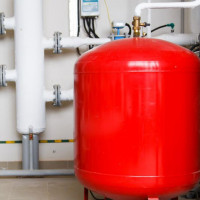 Pressure in the expansion tank of a gas boiler: norms + how to pump and adjust
Pressure in the expansion tank of a gas boiler: norms + how to pump and adjust 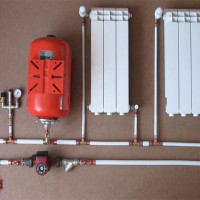 Expansion tank for closed heating: operating principle and device + how to choose and install in the system
Expansion tank for closed heating: operating principle and device + how to choose and install in the system  Expansion tank for open heating: device, purpose, main types + tips for calculating the tank
Expansion tank for open heating: device, purpose, main types + tips for calculating the tank 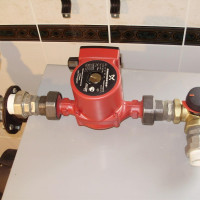 Installation of a circulation pump: types, purpose and features of its installation
Installation of a circulation pump: types, purpose and features of its installation 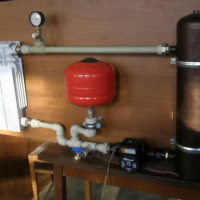 Expansion tank of the heating system: device, calculation and selection of the best option
Expansion tank of the heating system: device, calculation and selection of the best option  How much does it cost to connect gas to a private house: the price of organizing gas supply
How much does it cost to connect gas to a private house: the price of organizing gas supply  The best washing machines with dryer: model rating and customer tips
The best washing machines with dryer: model rating and customer tips  What is the color temperature of light and the nuances of choosing the temperature of the lamps to suit your needs
What is the color temperature of light and the nuances of choosing the temperature of the lamps to suit your needs  Replacement of a geyser in an apartment: replacement paperwork + basic norms and requirements
Replacement of a geyser in an apartment: replacement paperwork + basic norms and requirements